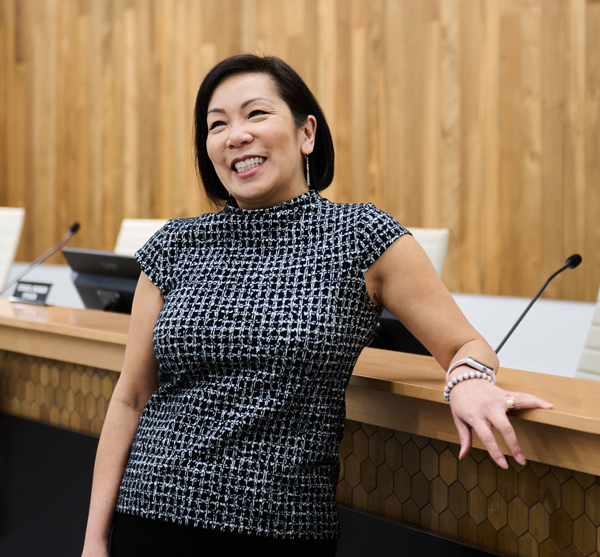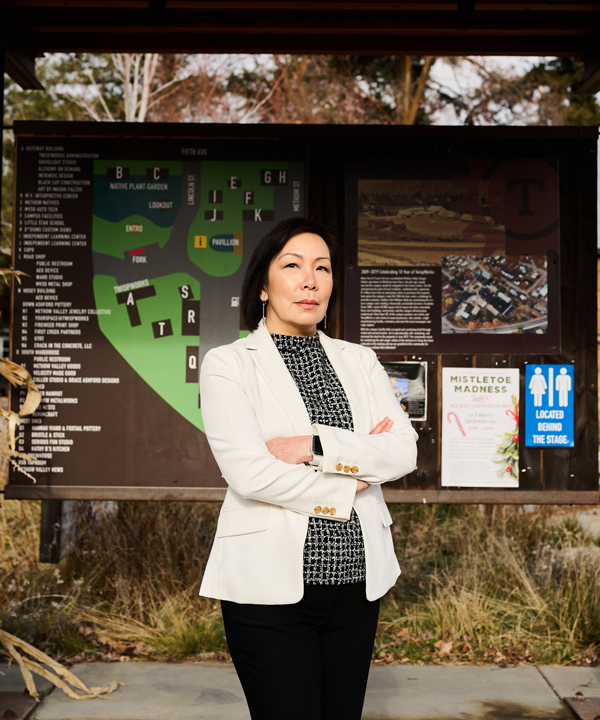by
<a href="mailto:communicationsteam@awcnet.org">Communications</a> | Dec 11, 2023
In the sunset of her final term as the mayor of Twisp, Soo Ing-Moody reflects on her legacy and the town’s resiliency.
In the sunset of her final term as the mayor of Twisp, Soo Ing-Moody reflects on her legacy and the town’s resiliency.
By: As told to Allyson Meyer

Twisp Mayor Soo Ing-Moody in Twisp Town Hall’s community room.
Credit: Chona Kasinger
You’ve been Twisp’s mayor since October 2010. What do most residents not know about you?
I grew up first-generation in North America, as both of my parents are immigrants from China. I’m the first in my family to have gone to university. I know the value of hard work, which was instilled in me by my parents. I would say philosophically, I’m curious about life and people in general. I tend to view the world optimistically, as a series of opportunities for us to collectively and individually be our better selves and I personally and intentionally strive towards that in everything I do.
What was a hallmark experience during your tenure as mayor?
The state’s largest wildfires that happened in our backyard—the 2014 Carlton Complex and 2015 Twisp River fires, in which three firefighters lost their lives defending our town. We experienced mandatory evacuation, we lost power, and [we] lacked the tools to properly manage an emergency, as we were cut off from the outside world with active fire around us—incapable of effective communication, even among first responders.
What changes have been made to make Twisp more resilient in the future?
The Twisp Civic Building/Emergency Operations Center that was completed last year does double duty as a town hall and emergency operations center when needed. It replaces our previous town hall that was literally falling apart. Additionally, during my tenure our incredible staff has worked to replace 89 percent of the aging water system, 100 percent of the sewer system deficiencies, and repaved approximately 94 percent of our roadways. These systems are our lifelines during wildfires, and having them repaired makes us more resilient to future climate emergencies, while also establishing a solid foundation for much needed economic growth, including housing.
Twisp historically was a timber town, but in the 1980s, the lumber mill closed and then, a decade later, the U.S. Forest Service relocated its Twisp headquarters to Winthrop. How did that impact the town’s identity?
Our whole existence was predicated on a past industry of logging and natural resource extraction and management. I recognized pretty early on that we didn’t have a cohesive town identity. We were still, as a community, living 20 years prior to where we were, and that was because we had gone through a series of losses. Our economy, our community psyche, was still very much wrapped up in what we used to be. I felt we really needed to come to terms with who we are now as a community and who we want to be, to embrace our history, but not to be stuck in it, and to look forward to what our opportunities could be.
I recognized pretty early on that we didn’t have a cohesive town identity. We were still, as a community, living 20 years prior to where we were, and that was because we had gone through a series of losses. Our economy, our community psyche, was still very much wrapped up in what we used to be.
In 2008, opportunity knocked when a benefactor purchased the abandoned Forest Service property for $1 million and donated it to the town, with the requirement that within 10 years it would be self-sustaining.
As a result of the donation, the Town of Twisp chartered the Public Development Authority (PDA) which became known as TwispWorks.
Then what happened?
We got a grant for branding ourselves and it was under the guise of branding, but really it was in my mind a coming out, because it required us to do a number of charrettes and interviews with key people in the community as well as just surveying local community members about who we really are—and that brought out the fact that we are heavily creative and extremely strong in getting things done.

Mayor Ing-Moody visits the TwispWorks campus.
Credit: Chona Kasinger
TwispWorks was chartered to promote the economic development of the Methow Valley as a small business incubator, focusing on four basic pillars of agriculture, arts, technology, and education. In 2019, a decade after its founding, the 6.4-acre campus achieved full occupancy and was self-sustaining through rental and earned income.
One of the most popular businesses on the TwispWorks campus is a Made in the Methow store that showcases the work of local artists and artisans—we have so many artists and artisans that work and live here in our town.
So many that in 2020, the Twisp Creative District became the fifth such district in the state to receive certification from the Washington State Arts Commision. What does that mean for the town?
That designation is absolutely authentic for us, and [with that designation] I’m hopeful for the future—that it can bolster an economy that has been forming for years in our community.
Any lessons learned for other cities and towns seeking to reinvent themselves?
TwispWorks began a reset for our town simply by creating an opportunity. It gave us the chance to come together and form a collective appreciation of the many things we already were and can be as a community. It gave us the space—physically and in our imaginations—to embrace and adapt to changing times, which has allowed us to be nimbler and more resilient as a result. So, it only seems natural that things like the growing arts industry became a part of that. The same I think is happening again with technology and education as the need for workforce development continues to exist and evolve. TwispWorks has in recent years become a training ground, figuratively as an economic incubator and literally with two on-site learning opportunities (an alternative school and auto shop). When community makes space and opportunity available, I believe we will adapt and naturally become more resilient.
It gave us the space—physically and in our imaginations—to embrace and adapt to changing times, which has allowed us to be nimbler and more resilient.
Once you’ve served out your final term as mayor at the end of the year, what’s next?
I tend to keep myself open to opportunity. I don’t have any definitive plans at the moment, but whatever I do, I will continue to be involved in some sort of impactful service. For the short term, I’d like to start working on a book—probably musings of a small-town mayor about community, sociology of community, leadership, adversity and how to see beyond it, and how to embrace opportunity.
What are some things you would you like to be remembered for?
Always trying to be open and transparent with the public, my staff, and colleagues. Empowering others with a positive outlook, my belief in inclusivity, and a can-do attitude as a complex problem-solver. That I am a seeker of common ground—a collaborator and bridge builder—and a tireless advocate for small and rural communities.
What advice would you pass on to other local electeds?
The first is to see challenges as opportunities; as leaders, we have to be able to see beyond our present moment. The second is that no one is an island, we need each other; the best leaders recognize they don’t actually do anything alone. The third is to be open to being uncomfortable, because that enables us to question what and why we are uncomfortable. Being open also means that we can seek answers requiring deep listening and the desire to hear other viewpoints. The last point for all leaders is, regardless of the size of the city, to be humble. The moment you start serving yourself, you cease to be a leader. It’s all about being that servant leader we’re called to be.